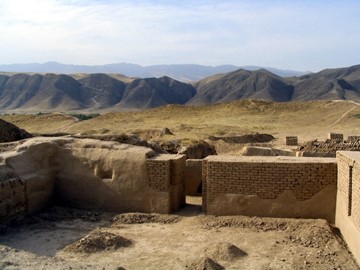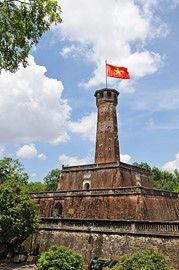region :: asia and the pacific
Ayutthaya
Ayutthaya, a UNESCO World Heritage site in Thailand, is a historic city founded in 1350 that served as the kingdom's capital until its fall in 1767. Renowned for its impressive ruins, including ancient temples, palaces, and statues, it showcases a blend of Khmer, Sukhothai, and local architectural styles. The site reflects the region's rich cultural and historical significance, drawing visitors to explore its well-preserved remnants and serene riverside setting.
Khao Yai Forest
Khao Yai Forest, a UNESCO World Heritage site in Thailand, is a biodiverse tropical rainforest renowned for its rich ecosystems and stunning landscapes. It hosts an array of wildlife, including elephants, gibbons, and rare bird species, alongside cascading waterfalls and scenic trails. Recognized for its ecological significance, the forest serves as a vital conservation area and a popular destination for nature enthusiasts.
Thungyai Huai Kha Khaeng
The Thungyai-Huai Kha Khaeng Wildlife Sanctuaries, a UNESCO World Heritage site in Thailand, form a vast, pristine conservation area along the Myanmar border. Recognized in 1991, these contiguous sanctuaries encompass diverse forest types, from tropical dry forests to savannas, and host an exceptional array of biodiversity, including tigers, elephants, and numerous rare species. The rugged landscape, with folded mountains and intact river systems, offers stunning natural beauty and serves as a critical stro... Read More
Ancient Merv
Ancient Merv, a UNESCO World Heritage site in Turkmenistan, stands as a testament to millennia of human civilization, once thriving as a key stop on the Silk Road. This archaeological treasure showcases remnants of successive empires, including the Achaemenids, Parthians, Sassanids, and Islamic dynasties, with structures like mausoleums, mosques, and fortified walls. Its historical significance lies in its role as a cultural and economic hub, blending Eastern and Western influences until its decline after a... Read More
Kunya Urgench
Kunya-Urgench, a UNESCO World Heritage site in Turkmenistan, is a historic city that flourished as a major trade and cultural center along the Silk Road from the 10th to 14th centuries. Once the capital of the Khwarazmian Empire, it features remarkable architectural remnants, including the 11th-century Kutlug Timur Minaret, one of the tallest in Central Asia, and the Turabek Khanum Mausoleum, renowned for its intricate tile work and dome. The site reflects a blend of Islamic architecture and regional influe... Read More
Fortresses of Nisa
The Parthian Fortresses of Nisa, a UNESCO World Heritage Site in Turkmenistan, are the remnants of an ancient capital of the Parthian Empire, a major power from the mid-3rd century BC to the 3rd century AD. This archaeological site features two tells—Old and New Nisa—showcasing unexcavated ruins that blend traditional Parthian culture with Hellenistic and Roman influences, evident in richly decorated structures tied to domestic, state, and religious life. Strategically located at a crossroads, it served as ... Read More
Itchan Kala
Itchan Kala, a UNESCO World Heritage site in Uzbekistan, is the historic inner town of Khiva, encircled by towering brick walls that once sheltered caravans before their desert journey to Iran. This well-preserved gem showcases Central Asian Islamic architecture with notable structures like the Djuma Mosque, ornate mausoleums, and grand palaces from the 19th century, reflecting its rich cultural legacy. Recognized in 1990, it stands as a testament to the region’s historical significance along the Silk Road.... Read More
Samarkand
Samarkand, a UNESCO World Heritage site in Uzbekistan, is a historic city renowned for its stunning Islamic architecture and rich cultural legacy. Known as a crossroads of ancient trade routes, it features iconic landmarks like the Registan, a grand public square framed by intricately tiled madrasas, and the Bibi-Khanym Mosque, famed for its colossal dome. The city’s mausoleums, such as the Gur-e-Amir, showcase exquisite craftsmanship and house the tombs of notable figures, reflecting its significance as a ... Read More
Shakhrisyabz
The Historic Centre of Shakhrisyabz, a UNESCO World Heritage site in Uzbekistan, is an ancient city along the Silk Road, renowned for its cultural and political significance during the 14th and 15th centuries under the Timurid Empire. It features exceptional monuments, including the grand ruins of the Ak-Saray Palace and the Kok-Gumbaz Mosque, showcasing Timurid architectural brilliance. As the birthplace of Amir Timur (Tamerlane), it reflects centuries of secular development, though it has been listed as a... Read More
Bukhara
The Historic Centre of Bukhara, a UNESCO World Heritage site in Uzbekistan, is a remarkably well-preserved example of a Central Asian Islamic city, showcasing over a thousand years of history. Its architectural treasures include the ancient Ark Fortress, the intricately designed Kalon Minaret, and numerous mosques, madrasas, and mausoleums reflecting the city’s role as a major Silk Road hub. This living museum highlights Bukhara’s cultural and religious significance, with its traditional bazaars and labyrin... Read More
Chief Roi Mata’s Domain
Chief Roi Mata’s Domain, Vanuatu’s first UNESCO World Heritage site, inscribed in 2008, encompasses sites linked to the life and death of the last paramount chief, Roi Mata, from the early 17th century. This cultural landscape reflects his enduring legacy of social reforms and conflict resolution, preserved through oral traditions and archaeological evidence. The site, under traditional and legal protection, remains significant to local communities, who maintain its integrity and offer cultural tours to edu... Read More
Ha Long Bay
Ha Long Bay, a UNESCO World Heritage site in Vietnam, is renowned for its stunning natural beauty, featuring thousands of limestone karsts and emerald waters. This iconic seascape, dotted with dramatic islands, caves, and floating villages, showcases a unique blend of geological wonders and cultural heritage. Its biodiversity and striking landscapes make it a globally celebrated destination for travelers and nature enthusiasts.
Hué
The Complex of Hué Monuments, a UNESCO World Heritage Site in Vietnam, showcases the grandeur of the Nguyen Dynasty, which ruled from 1802 to 1945. This historic ensemble includes the fortified Citadel, the Imperial City, and the Forbidden Purple City, along with royal tombs, temples, and pagodas, all harmoniously integrated with the natural landscape. Recognized in 1993, it exemplifies eastern feudal architecture and urban planning, reflecting Vietnam’s rich cultural and political heritage. Despite wartime... Read More
Hoi An
Hoi An Ancient Town, a UNESCO World Heritage site in Vietnam, is a remarkably well-preserved trading port dating back to the 15th century. Known for its blend of local and foreign architectural influences, the town features narrow streets lined with colorful lanterns, historic wooden buildings, and ornate temples. Once a bustling hub for merchants from China, Japan, and Europe, it now thrives as a cultural landmark, offering a glimpse into its rich past through its timeless charm and serene riverside settin... Read More
My Son
My Son, a UNESCO World Heritage Site in Vietnam, is a remarkable collection of ancient Hindu temples built by the Champa Kingdom between the 4th and 13th centuries. Dedicated primarily to the deity Shiva, the site features intricately carved red-brick towers that reflect a unique blend of Indian and local architectural influences. Despite damage from time and conflict, including the Vietnam War, its well-preserved ruins offer a vivid glimpse into the spiritual and cultural history of the Cham civilization. ... Read More
Hanoi Citadel
The Imperial Citadel of Thang Long - Hanoi, a UNESCO World Heritage site in Vietnam, is a historic fortress that served as the political and military center of the region for over a thousand years. Originally built in the 11th century during the Ly Dynasty, it showcases a blend of architectural styles reflecting its evolution through various ruling eras. Today, it stands as a significant cultural landmark, housing archaeological remains, ancient structures, and museums that offer insights into Vietnam’s ric... Read More
Citadel of the Ho Dynasty
The Citadel of the Ho Dynasty, a UNESCO World Heritage site in Vietnam, is a remarkable 14th-century fortress built during the short-lived Ho Dynasty. Constructed in 1397 using large stone blocks, it showcases advanced architectural techniques and reflects the influence of Confucian urban planning. The citadel served as the political, economic, and cultural center of the dynasty until its fall in 1407. Today, it stands as a well-preserved testament to Vietnam’s historical and cultural legacy.
Phong Nha Ke Bang
Phong Nha-Ke Bang, a UNESCO World Heritage site in Vietnam, is renowned for its extensive limestone karsts, vast cave systems, and rich biodiversity. It features some of the world’s largest and most spectacular caves, including Son Doong, alongside underground rivers and unique geological formations. The site also harbors diverse ecosystems with rare flora and fauna, making it a significant natural treasure and a global conservation priority.
Trang An
The Trang An Landscape, a UNESCO World Heritage site in Vietnam, is a stunning blend of natural and cultural wonders. Recognized in 2014 as the country’s first mixed heritage site, it features dramatic limestone karst peaks, lush rainforests, and a network of subterranean waterways navigable by boat. Archaeological evidence reveals human activity spanning over 30,000 years, while historical sites like the ancient capital of Hoa Lu highlight its significance from the 10th and 11th centuries. This picturesque... Read More


















